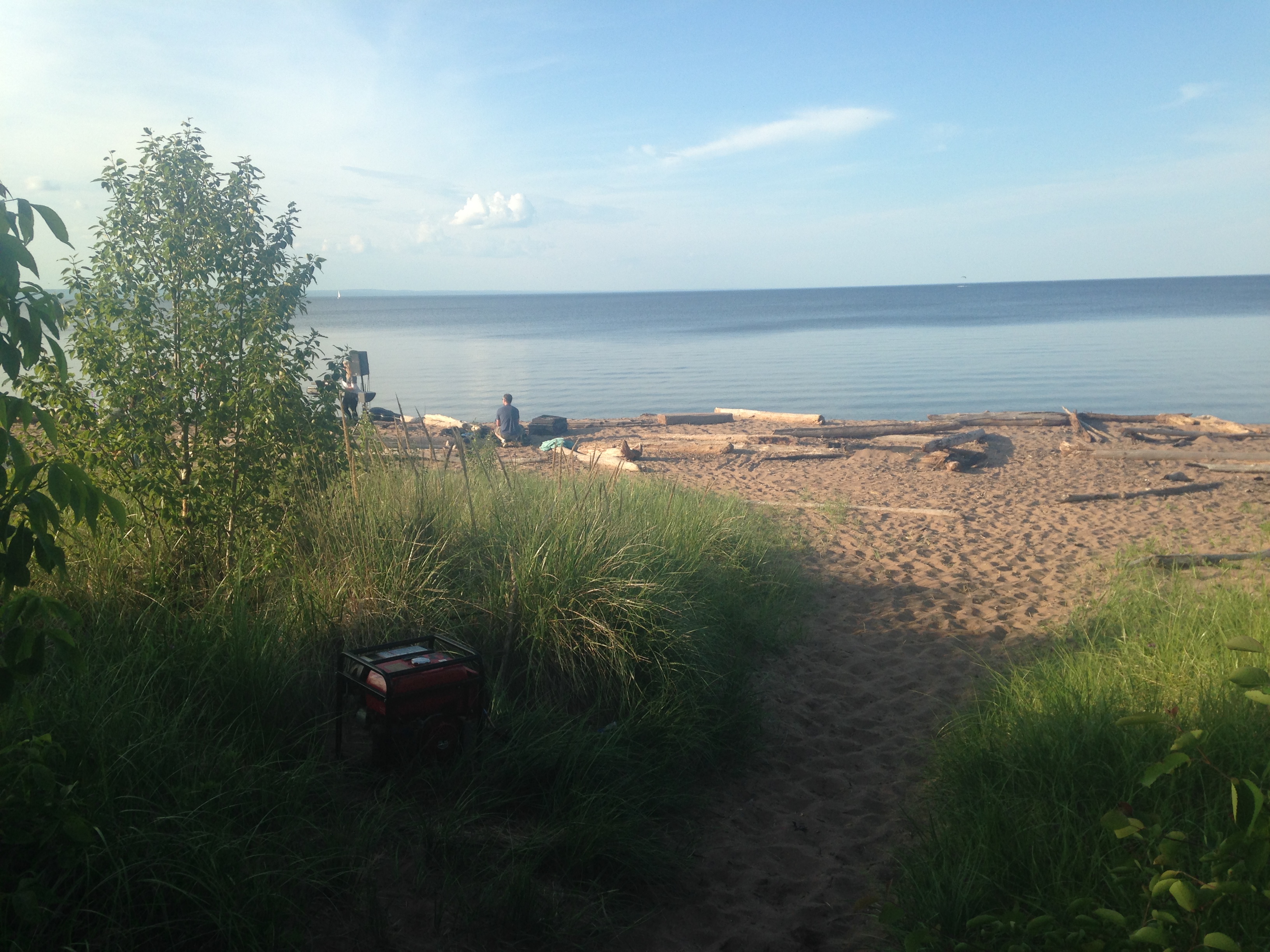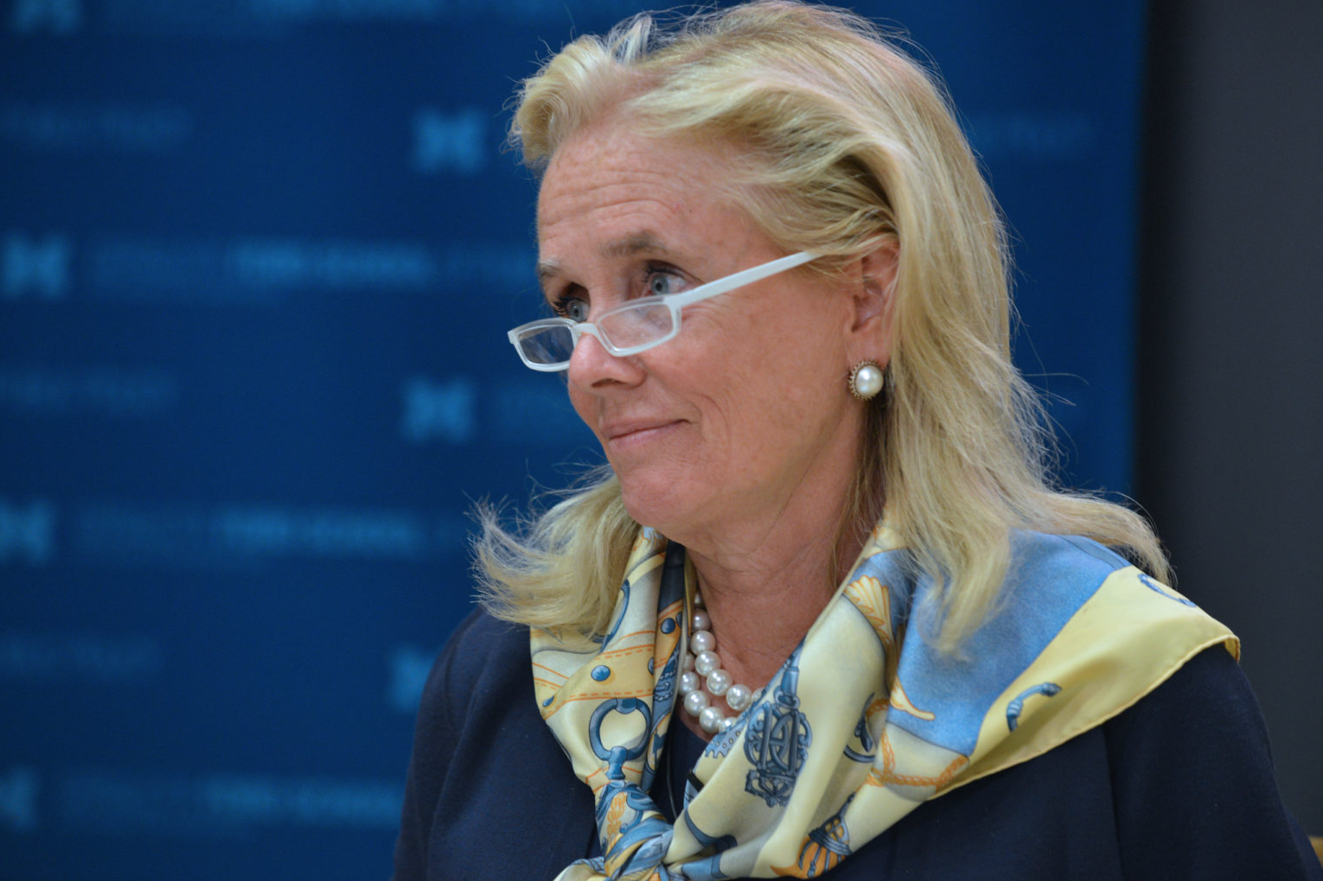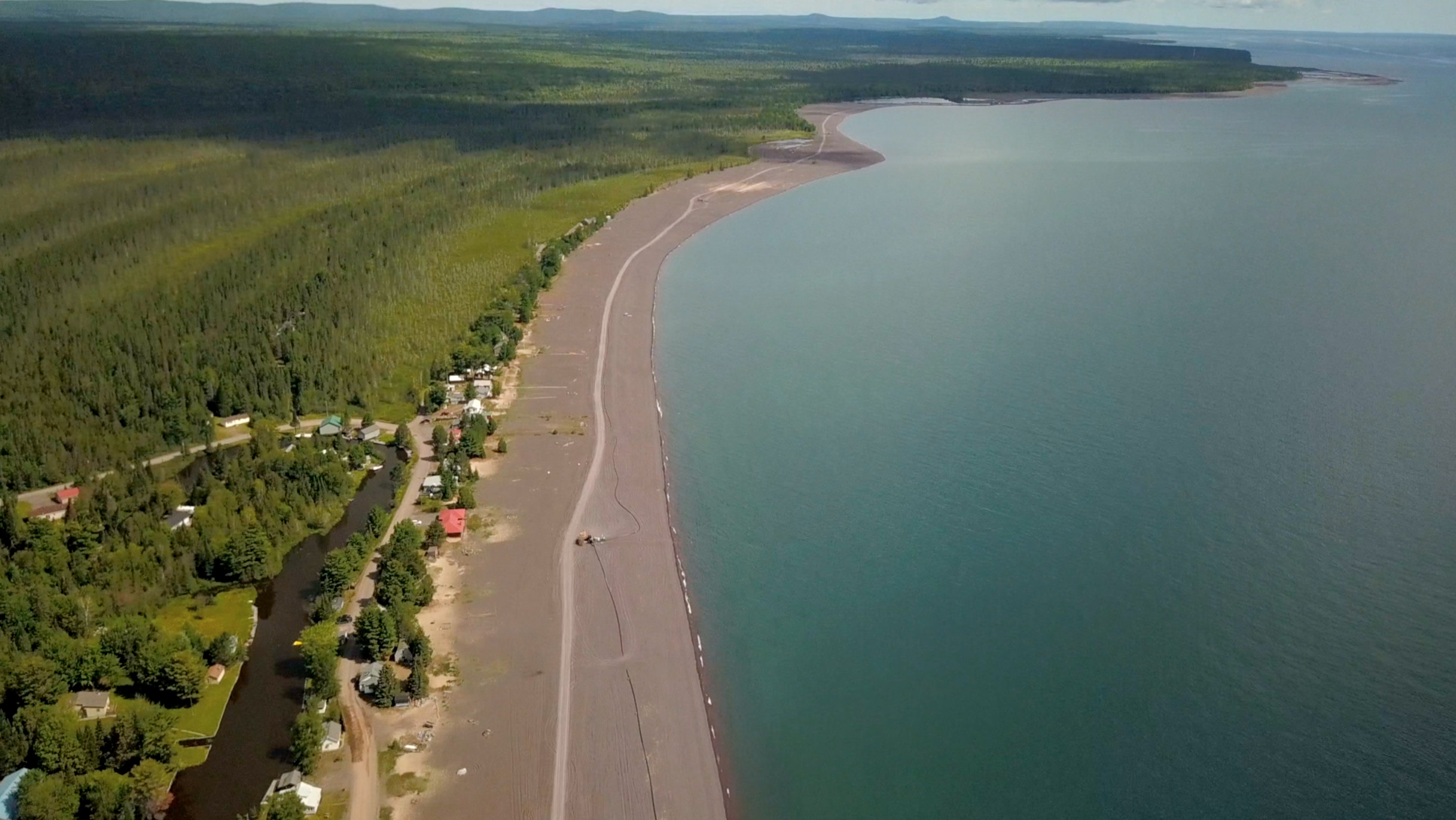
By Walker Orenstein, MinnPost
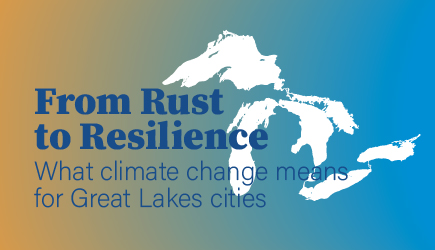
This article is part of the Pulitzer Center’s nationwide Connected Coastlines reporting initiative. For more information, go to pulitzercenter.org/connected-coastlines-initiative.
For all stories in the “From Rust to Resilience” project, including the Great Lakes Now monthly show, click HERE.
Last year, a Harvard professor branded Duluth as a “climate-proof” sanctuary for its cold weather, access to fresh water and for infrastructure that could absorb a rush of new residents fleeing warmer places.
Yet Duluth is far from climate-proof. Storms that have already battered shorelines, put homes at risk and damaged city treasures like its Lakewalk pedestrian trail are expected to become stronger. Rains that have already strained sewer systems and flooded infrastructure may become heavier.
As a result, there has been a growing climate movement in Duluth, a city that has increasingly advertised itself as an outdoor haven with access to fresh air, clean water and Lake Superior. Officials there are working to fortify infrastructure and slash greenhouse gas emissions from city government. Climate advocacy groups have also launched projects to build solar gardens, develop more sustainable housing and improve residential energy efficiency.
But for environmental advocates who want a carbon-free Duluth, their biggest roadblock may be a unique and influential hometown utility that not only serves the city but also a stable of energy-hungry taconite mines and paper mills that have long been critical to the region’s economy, and its identity: Minnesota Power.
“If Duluth really is going to identify itself as a resilient and sustainable community where all are welcome, we need to walk the walk,” said Jenna Yeakle, a Duluth organizer for the Sierra Club’s Beyond Coal and Clean Energy campaign. “We can’t be contributing to climate change while also being home to many who are seeking refuge.”
Industry and city, powered by coal
Minnesota Power provides electricity for 145,000 residential and commercial customers across northern Minnesota, including Duluth, and counts 1,020 full-time and part-time employees. Its parent company, ALLETE Inc., also owns a North Dakota coal mine, a clean energy company, and another utility that provides water, gas and electricity to Superior, Wisconsin.
Minnesota Power has been an institution in Duluth for a century. Founded in the early 1900s, the company generated hydropower initially through a dam on the St. Louis River, which flows through Duluth into Lake Superior.
As the region’s mining and forestry industries expanded over the last century, so did Minnesota Power’s reach, and the utility eventually built a fleet of coal-fired power plants to support growing cities, towns and industry across the Northland. By 2005, 95 percent of the company’s energy came from coal, and the reason was simple, said Julie Pierce, vice president of strategy and planning for Minnesota Power: Coal was the cheapest and most reliable form of energy.
And the company needs a lot of it.
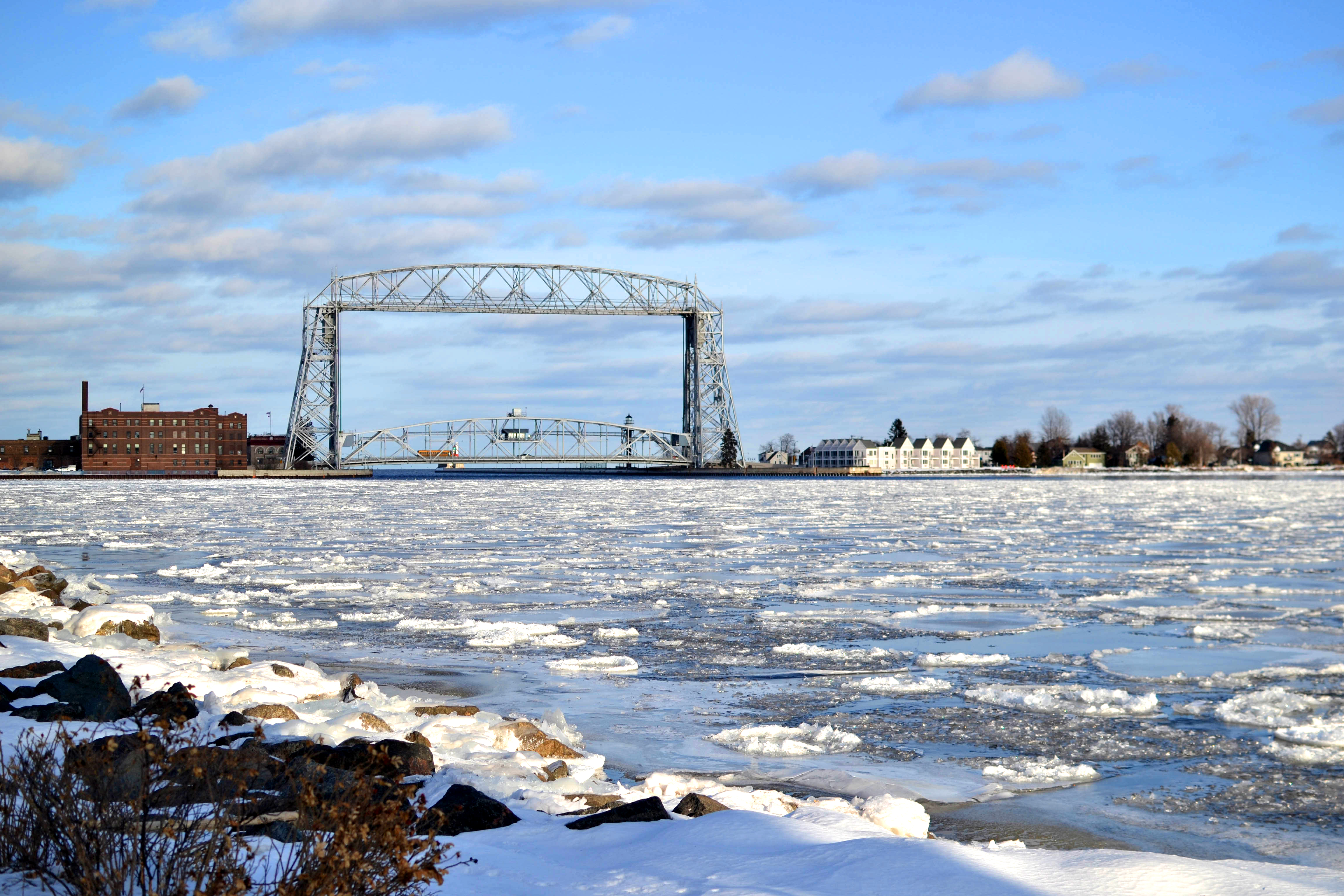
Duluth’s Aerial Lift Bridge, a city landmark and passageway for ships between the city’s port and Lake Superior. MinnPost photo by Walker Orenstein, Feb. 12, 2020.
That’s because while the utility serves a fraction of the total customers that neighboring Xcel Energy does in the Twin Cities, Minnesota Power feeds a small group of energy-intensive large industrial customers. Currently, about 74 percent of Minnesota Power’s energy is sold to industrial operations, and most of that electricity heads to just six taconite facilities and four paper and pulp mills scattered throughout the region.
That customer mix is unique in Minnesota and rare — perhaps unheard of — across the country.
Minnesota Power estimates one U.S. Steel mine alone needs roughly the same energy as the City of Minneapolis, which has more than 400,000 residents. The electricity use of Duluth, population 86,000, is tiny by comparison. Those mines and mills have long been a pillar of the northern Minnesota economy, powering direct and indirect jobs in Duluth, such as shipping.
Despite its robust coal portfolio, after 2005, Minnesota Power began to shift away from the fuel. Pierce said improving technology for renewable energy made it possible. But federal tax credits for wind power made a transition cheaper. It also wasn’t entirely up to Minnesota Power; a 2007 state law ordered utilities to have 25 percent renewable energy by 2025.
The company cleared that benchmark early. Over a decade and a half, Minnesota Power built a massive wind farm in North Dakota and struck a deal to buy large quantities of hydropower from a Manitoba utility starting in June 2020. The utility also bought and repurposed a transmission line and built another to harness the resources. A third is under construction by Manitoba Hydro.
Because of those investments, and others, Minnesota Power has closed or idled five of the nine coal-fired generating units it had in 2005 and converted another pair to natural gas. About 30 percent of the utility’s power is now generated by renewable sources. Minnesota Power plans to stretch that to 50 percent by 2021 after it adds a wind farm in Southwest Minnesota, the hydropower from Canada and more solar electricity to its portfolio.
Nearly all of the renewable energy will be carbon-free, though Minnesota Power does produce some energy from biomass. “We like to identify how we’ve gone faster and further with our transition in a very thoughtful way,” Pierce said.
A climate movement grows in Duluth
As Minnesota Power has changed in response to climate change, so has Duluth.
More than many communities in Minnesota, Duluth is already facing problems created or exacerbated by climate change, said city Councilman Joel Sipress. For instance, more extreme weather is contributing to erosion that threatens homes and businesses in Park Point and straining stormwater infrastructure. This year, the city asked the Legislature for $13.5 million in state bonding money to fortify coastline infrastructure like seawalls and the Lakewalk.
And people are taking notice. “In Duluth, over the last year or two, many in the community have come to recognize that climate change is not a future problem but is now a present problem,” Sipress said. “If we don’t start getting serious right now it’s going to become an increasingly serious problem in the future.”

Duluth’s Park Point neighborhood, a stretch of land vulnerable to erosion and lake storms that are increasing in severity. MinnPost photo by Paul Walsh, April 4, 2020.
That climate awareness has grown in tandem with a city shifting away from an industrial past toward higher education, health care and small businesses like breweries, said Bret Pence, a Duluth resident who serves as Greater Minnesota director for the climate advocacy group Minnesota Interfaith Power and Light.

Bret Pence
For more than a decade, the city has marketed itself as an “outdoors town,” where people are connected to the environment and Lake Superior, Pence said. And that has been a big part of Duluth’s “revival,” he said. “People move here because of the outdoors often and then find a job, rather than the other way around.”
Minnesota Power’s trajectory is, for some in Duluth, too slow. Pence noted Duluth quickly joined the Paris Agreement on climate change after President Donald Trump’s administration pulled out, and Mayor Emily Larson, who recently hired a sustainability coordinator, has committed to reducing city emissions 80 percent by 2050.
Is Minnesota Power resisting clean energy?
While Minnesota Power is approaching that 50 percent renewable milestone, it’s still grappling with questions about its energy production. One of those questions is whether the company will shut down its last two coal-fired generators.
The two units — at the Boswell Energy Center, 90 miles northwest of Duluth in the small city of Cohasset — will be considered for retirement or operating extensions in 2035 and 2036, though some environmental advocates hope they are shuttered earlier.
Iron mines have been vocal in their opposition to early retirement for the plants. The Iron Mining Association of Minnesota proposed state legislation to require that Boswell stay open unless it’s cheaper to build and operate clean energy and infrastructure like transmission lines. Minnesota Power supported the idea, even as the company has remained tight-lipped about its long-term plans.
What’s next for the coal plants will become clearer later this year, when Minnesota Power files a 15-year plan with state regulators.
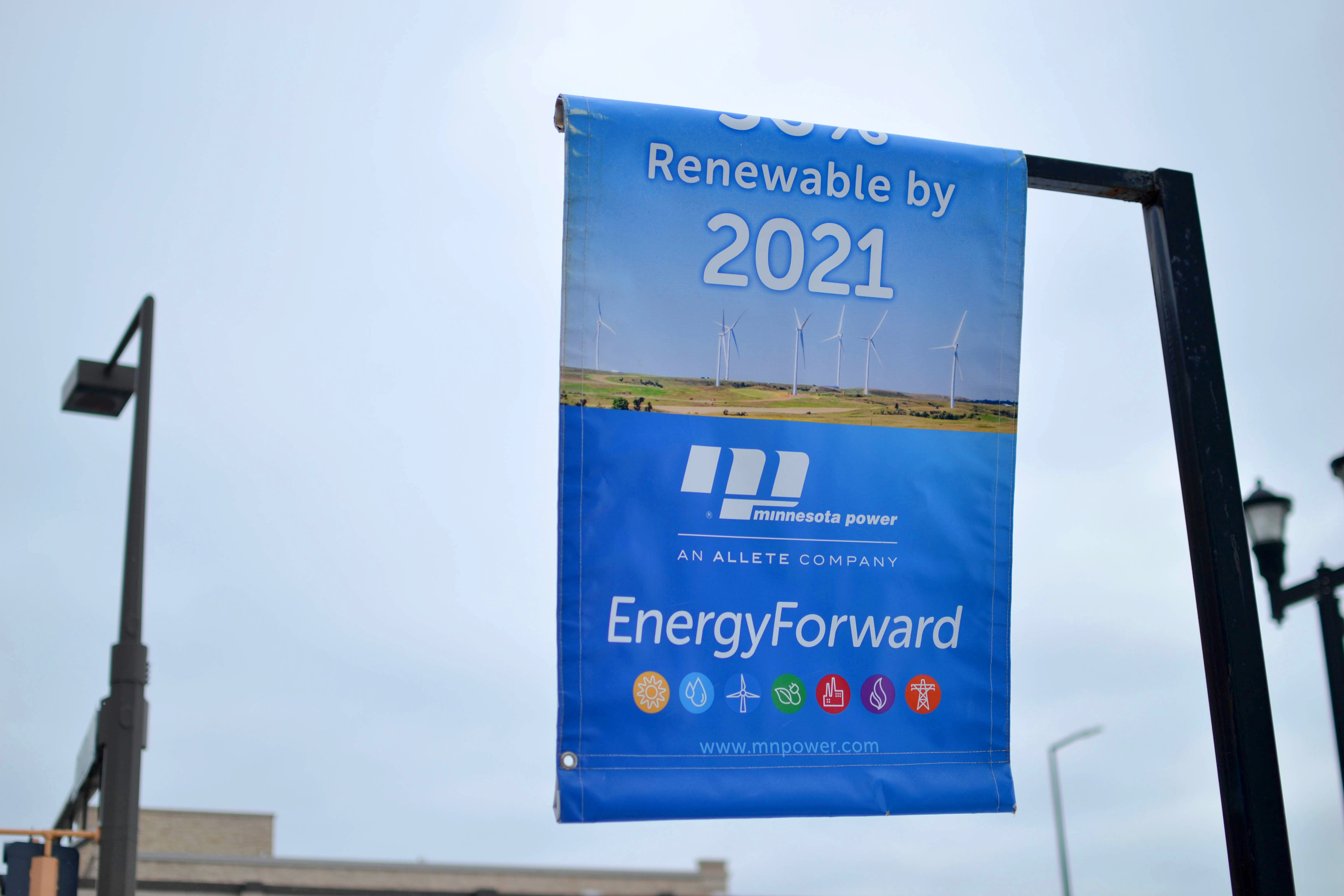
Signs hang in downtown Duluth promoting Minnesota Power’s goal to produce 50 percent of its energy from renewable resources by 2021. MinnPost photo by Walker Orenstein, Feb. 12, 2020.
But the climate debate goes beyond coal for Minnesota Power. The utility wants to build a $700 million natural gas plant in Superior, Wisconsin, known as the Nemadji Trail Energy Center. Yet the plant faces stiff opposition from environmental advocates, who warn it could become outdated and expensive as renewable technology advances. Even large industrial customers argued it was not the cheapest power option. And while the Nemadji Trail plant was approved by Minnesota regulators, the state Supreme Court is considering whether it should undergo environmental review in Minnesota.
As Gov. Tim Walz and other state Democrats push for a new law to require carbon-free energy by 2050, the utility has not taken a position on their 2050 clean energy bill, or otherwise pledged to be free of emissions by midcentury.
By contrast, Xcel Energy says it will be coal-free by 2030 and 100 percent carbon-free by 2050. Xcel has also surpassed 50 percent carbon-free power in the Upper Midwest, though much of that is from nuclear energy, which Minnesota law does not count as renewable.
Minnesota Power has not taken a stance on another bill, this one with some Republican support, to make adding new fossil fuel power more difficult. “To me it looks like they are publicly just committing themselves to a goal that they’ll meet next year,” Yeakle, the Sierra Club organizer, said of the utility’s 2021 pledge. “And they aren’t putting forward any long-term goals or vision.”
The utility has also thrown its considerable power and influence behind a new crude oil pipeline planned to cross northern Minnesota: It leads Jobs for Minnesotans, a coalition of labor and business that is fighting for the Enbridge Line 3 pipeline and two copper-nickel mines under consideration in northern Minnesota.
Minnesota Power plans to supply energy for the pipeline and one of the new mines. The second mine hasn’t chosen a power provider yet. (The utility says the pipeline won’t increase energy demand because it expects the pipeline to be more efficient and run a different route from a smaller one it will replace. Some argue Line 3 won’t increase emissions, since oil will simply be transported by rail if the pipeline is not built.)
A mantra of low-cost, reliable power
The utility still says it’s doing much better at fighting climate change than some of its critics contend. The company says it offers the highest percentage of renewable power among large utilities in Minnesota, and is second in the Upper Midwest, even though northern Minnesota is not a particularly windy or sunny region for producing renewable power.
And despite the hefty, around-the-clock electricity needs of the mines and mills it serves, Minnesota Power’s 2021 goal for 50 percent renewable energy is ahead of all utilities in the state, Pierce said. The utility’s clean-power strides come without help from nuclear plants, which Xcel has benefited from since the 70s. Pence, the clean energy advocate, also praised some Minnesota Power programs, like its rebate program for installing solar.
“I often like to ask folks, how important is it that someone put out a goal for 2050 versus what they’re doing right now?” said Pierce, of Minnesota Power. “Obviously we’ve put out markers too, like 50 percent (renewable power).”
As it develops its 15-year plan, Pierce said the utility is “excited about looking at alternatives” for coal. But the utility’s priorities include more than a carbon-free power mix. Pierce said its focus is on balancing clean electricity improvements with reliable, safe, low-cost energy that creates and protects jobs.
For instance, mills and mines worry that the price of new clean power infrastructure could spike their rates, at least in the short term. Costs have already increased between 50 to 70 percent for industrial customers as Minnesota Power has made its energy transition, Pierce said.

Duluth’s Canal Park neighborhood, which hugs the waterfront of Lake Superior. MinnPost photo by Gregg Aamot, Nov. 30, 2018.
Kelsey Johnson, president of the Iron Mining Association, said the higher energy bills put them in danger of being uncompetitive in the global industry. And recent Boswell renovations have cost hundreds of millions of dollars that Johnson said shouldn’t go to waste.
“We know the importance of these customers to this region, to (Duluth), to the Greater Minnesota economy,” Pierce said. “They make up 10 percent of our economy, they’re 8,000-plus jobs. They are somewhat of a lifeblood of the northern part of this state and we need to hear their voices.”
One reason the company wants to build the Nemadji trail gas plant is to make sure power service won’t be interrupted by the sporadic production of wind and solar. Plus, delivering new renewable power vast distances can be complex, Pierce said, and requires lengthy planning for expensive infrastructure like transmission lines. Boswell is the last so-called “baseload power” Minnesota Power has in the region.
“It is harder when you’ve got a high concentration of rural, heavy, industrial (power) load,” she said. “There are different considerations than if you’re downtown Minneapolis. It just is the nature of how electricity works.”
But Pierce said Minnesota Power has met the needs of Duluth residents, too. Especially during the coronavirus pandemic that has crimped the economy, said spokeswoman Amy Rutledge. “Safe, reliable, affordable power, number one through three on their list” of priorities, Pierce said. “All day, always.”
Environmentalists push for faster transition
That view is not shared by all in Duluth.
“Our opinion is that they are right now engaged in greenwashing,” said Pence, of Interfaith Power and Light.
While he commended Minnesota Power for adding clean energy when required, Pence said the utility has often done so while fighting green regulations along the way.
In 2007, the company opposed the state’s energy standard for 25 percent renewable power by 2025, a law that Minnesota Power now cites as one reason for dropping much of its coal. And in 2014, the company settled with the federal government while facing allegations that it violated anti-pollution laws at its coal plants. It paid $500 million to make anti-pollution upgrades at its coal plants, among other concessions.
Minnesota Power also sued the Obama administration over its 2015 Clean Power Plan, which required states to reduce carbon emissions — even though the utility said at the time it could likely comply. (Minnesota Power said it opposed the 2007 state law for being a mandate and Obama’s rules for creating an unclear regulatory process, though it did not oppose adding clean energy itself. The Obama power plan has since been unraveled by the Trump administration.)
Pence said clean energy groups like Interfaith Power and Light have won concessions from Minnesota Power before state regulators on the Public Utilities Commission, too. If advocacy groups “don’t intervene and show the facts,” then choosing clean energy is “not their default,” Pence said.
Those organizations are now gearing up to convince state regulators that Minnesota Power does not need the Nemadji Trail gas plant in its long-term plans or the Boswell coal units for another 15 years. Especially as the price of wind and solar has dropped nationwide and coal continues to become more expensive.
Two leading clean energy nonprofits, Fresh Energy and the Minnesota Center for Environmental Advocacy, are still working on modeling and research to lay out exactly what their alternative vision looks like. Yet both say Minnesota Power could expand its renewable energy portfolio beyond existing plans without threatening reliability.
Allen Gleckner, senior director of energy markets and regulatory affairs for Fresh Energy, said the state government should intervene to help communities impacted by a switch to clean power, like Cohasset.
While Boswell is open, Pence said Minnesota Power could also pursue novel carbon-cutting strategies that Xcel plans to try, such as using coal only during the winter and summer, when more energy is needed, and otherwise idling the plants.
A political split in northern Minnesota
The future of the utility has divided elected officials.
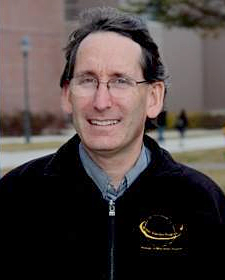
Joel Sipress
Sipress, the city councilman, said Duluth has been primarily focused on reducing the city’s own carbon footprint, despite interest in the community for putting more pressure on Minnesota Power. Climate advocacy groups have been preparing a “mobilization plan” to pressure city leaders into declaring a climate emergency that would speed transition to carbon-free energy, Sipress said. It’s in the long-term interest of mines and mills to act now, he said. “One of my fears is that if we drag our heels in northern Minnesota on energy transition we may face the danger of being forced to make that transition without proper planning,” Sipress said.
Yet the utility has plenty of allies. One is Arik Forsman, a city councilman whose primary job is to help lead economic development for Minnesota Power. (He said he has recused himself from votes related to the utility.)
While Forsman said he shares the mayor’s vision for Duluth’s own energy transition, which includes weaning a city-owned steam plant off coal, he said Minnesota Power’s work to keep local jobs and low rates for all customers is important, too.

Arik Forsman
While he’s heard from people at council meetings asking the utility to go “further, faster” Forsman said he’s been in meetings with employees of Taconite Harbor Energy Center — a coal plant along the North Shore of Lake Superior that was partially closed in 2015 and then idled in 2016 — whose families were “upended” when they lost their job.
Plus, he said, Minnesota Power is ahead of industry-heavy utilities elsewhere in planning for an energy transition, making it more competitive in a changing sector.
Most state legislators in the region have also been staunch supporters of mines and mills, which have pressured Minnesota Power to keep Boswell running. Many support Line 3 and the proposed copper-nickel mines, too, for the jobs they would create.
State Sen. Erik Simonson of Duluth, the top Democrat in the Senate’s Energy and Utilities Finance and Policy Committee, said new technology may be able to help the utility get rid of carbon emissions entirely in the future, but he has to look at Minnesota Power through an “economic lens, too.”
“It’s not to say that I’m a big coal proponent,” Simonson said. “But it is to say that I pretty firmly believe that we need to generate this baseload power for these businesses to survive, for those employees to keep their jobs and keep these communities going.”
Ben DeNucci, chairman of the Itasca County Board of Commissioners, told a Senate panel recently that 13 percent of the county’s tax base comes from the Boswell plant and its lifespan “is a huge deal to us.” The jobs are “some of the best jobs in our county.”
“We cannot afford or absorb Minnesota Power’s plant going away,” DeNucci said.

Emily Larson
At the center of this divide is Duluth Mayor Larson. While Minnesota Power was slow to begin an energy transition, she said, they are quickly making up ground and being a “good partner” in working with a city that sometimes has different energy goals.
And while Larson has prioritized reducing Duluth’s government emissions, she said that doesn’t mean Minnesota Power isn’t facing pressure to ramp up carbon-free energy faster. Larson said Duluth residents do influence the utility, and their activism makes it easier for her to press for bold climate change policy. “The push (for Minnesota Power) comes from living in a city that wants to see and do more,” Larson said.
“From Rust to Resilience: What climate change means for Great Lakes cities” is a collaborative reporting project that includes six members of the Institute for Nonprofit News (Belt Magazine, The Conversation, Ensia, Great Lakes Now at Detroit Public Television, MinnPost and Side Effects Public Media) as well as WUWM-FM Milwaukee, Indiana Public Broadcasting and The Water Main from American Public Media.
This project is part of the Pulitzer Center’s nationwide Connected Coastlines reporting initiative. For more information, go to pulitzercenter.org/connected-coastlines-initiative.

Featured image: Julie Pierce, vice president of strategy and planning for Minnesota Power, at the utility’s headquarters in downtown Duluth overlooking Lake Superior. MinnPost photo by Walker Orenstein, February 12, 2020.


